The dangers hydrangeas pose to dogs are often underestimated, with their toxicity presenting a serious risk to canine companions. Understanding the implications of hydrangea ingestion is crucial for responsible pet ownership.
By being aware of the potential harm these plants can cause and implementing practical strategies to mitigate risks, dog owners can ensure the safety of their beloved pets.
Stay tuned to learn practical tips and expert advice on safeguarding your pooch around hydrangeas and creating a secure environment for them to thrive in.
Key Takeaways
- Hydrangeas are toxic to dogs due to cyanogenic glycosides in all parts.
- Prevent poisoning by keeping hydrangeas in front yards or fenced off from pets.
- Watch for symptoms like vomiting, lethargy, and difficulty breathing if ingestion occurs.
- Opt for dog-safe shrubs like rose or magnolia in place of hydrangeas for pet-friendly gardens.
Hydrangeas Toxicity Overview
Hydrangeas Toxicity Overview
Hydrangeas pose a significant threat to dogs due to the presence of cyanogenic glycosides in all parts of the plant, making them toxic upon ingestion. This toxicity can lead to symptoms such as gastrointestinal irritation, vomiting, lethargy, diarrhea, hypotension, tremors, brick-red gum coloring, and difficulty breathing.
It is crucial for pet owners to be aware of these dangers and take preventive measures like placing hydrangeas in areas inaccessible to dogs or fencing them off. Monitoring for any signs of poisoning is essential for early detection and seeking veterinary care promptly if significant ingestion occurs. Understanding the risks associated with hydrangeas can help ensure the safety and well-being of dogs around these plants.
Understanding Cyanogenic Glycosides
Cyanogenic glycosides are a group of compounds found in various plant species that can release cyanide when metabolized. When a dog ingests hydrangeas, these cyanogenic glycosides can pose a serious risk. Once consumed, the dog's digestive system breaks down these compounds, releasing cyanide into the bloodstream.
Cyanide interferes with oxygen utilization at a cellular level, leading to symptoms of poisoning. It's essential for dog owners to be aware of this chemical compound in hydrangeas and take preventive measures to keep their pets safe.
Understanding the presence of cyanogenic glycosides in hydrangeas highlights the importance of monitoring and restricting access to these plants to prevent accidental ingestion and potential cyanide poisoning in dogs.
Signs of Hydrangeas Poisoning
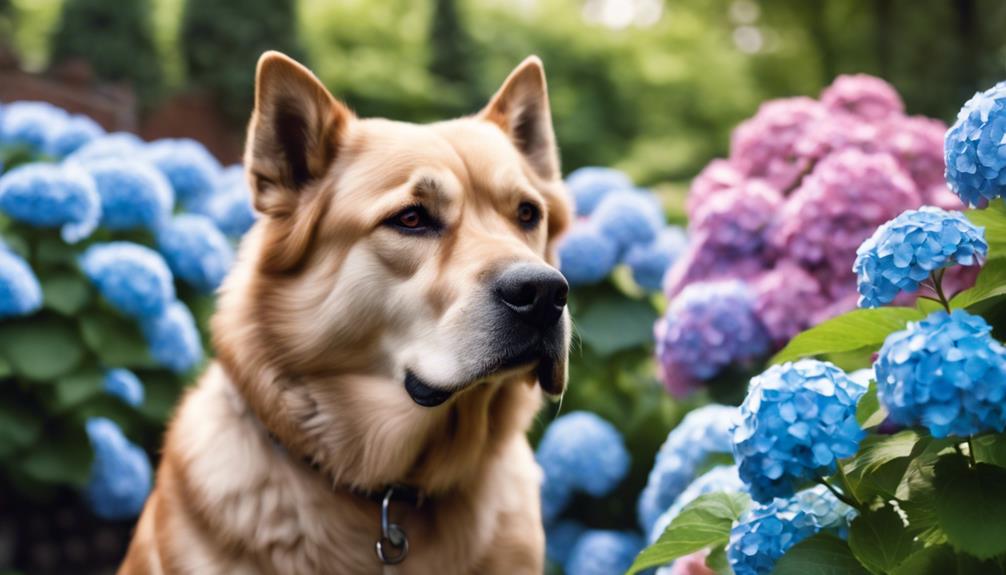
Manifesting as gastrointestinal distress and neurological abnormalities, signs of poisoning from hydrangeas in dogs must be promptly recognized for swift intervention.
To identify potential hydrangea poisoning in dogs, watch out for:
- Gastrointestinal irritation such as vomiting, diarrhea, and lethargy.
- Signs of cyanide poisoning like hypotension and tremors.
- Physical manifestations like brick-red gum coloring and breathing difficulties.
- Monitor closely for any unusual symptoms and seek immediate veterinary assistance if any of these signs are observed.
Early detection and treatment are crucial in ensuring the well-being of your canine companion.
Symptoms to Watch For
When observing a dog for potential poisoning from hydrangeas, vigilance towards specific symptoms is paramount for early detection and appropriate intervention. Typical signs of hydrangeas poisoning in dogs include gastrointestinal distress such as vomiting, lethargy, and diarrhea.
Cyanide poisoning may manifest as hypotension and tremors. Additionally, keep an eye out for brick-red gum coloring and breathing difficulties, as these can indicate serious toxicity.
Monitoring your pet closely for these symptoms is crucial, as prompt recognition can lead to timely treatment and a better prognosis. If you suspect hydrangea ingestion, seek veterinary care immediately to ensure proper management and care for your furry companion.
Preventive Measures for Dogs
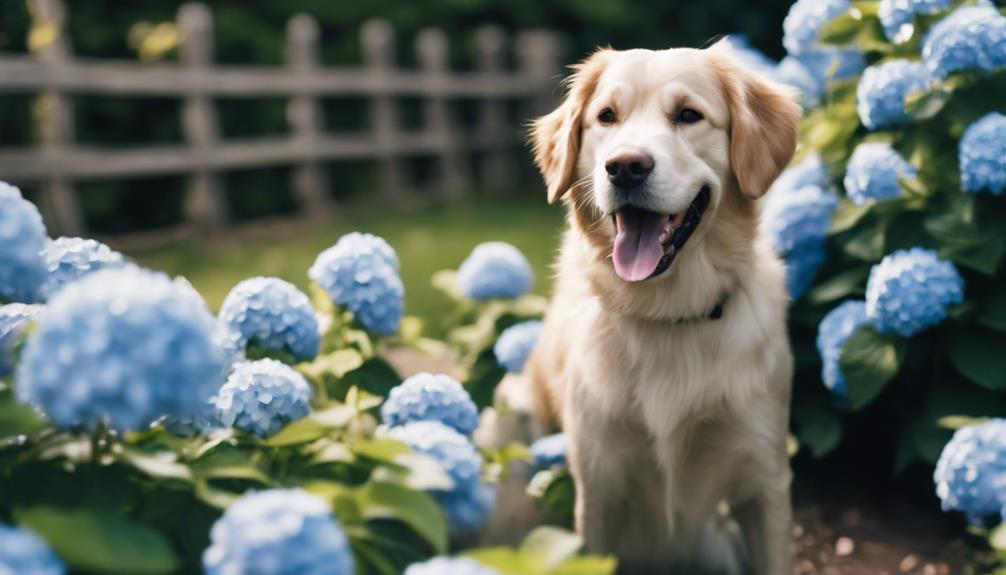
To safeguard your canine companion from the potential hazards of hydrangeas, implementing preventive measures is imperative in maintaining a safe environment for your dog. Here are some key steps to consider:
- Plant Placement: Position hydrangeas in areas inaccessible to your dog.
- Physical Barriers: Install fencing or barriers around hydrangea plants to prevent your dog from reaching them.
- Training: Train your dog to avoid specific areas or plants in the garden.
- Supervision: Keep a close eye on your dog when they are outdoors near hydrangeas to prevent any potential ingestion incidents.
Managing Hydrangeas Ingestion
What are the recommended steps for effectively managing hydrangeas ingestion in dogs to ensure their well-being and safety?
If a small amount of hydrangeas is ingested, monitor the dog at home for any signs of gastrointestinal stress such as vomiting or diarrhea.
In cases where a large amount of hydrangeas has been consumed, it is crucial to seek veterinary care immediately. Decontamination and monitoring are essential for significant ingestions to prevent further complications.
Contacting the Pet Poison Helpline or ASPCA Animal Poison Control Center can provide guidance on the next steps to take.
Additionally, being knowledgeable about other toxic plants for dogs and keeping them away from pets can help prevent accidental ingestion and poisoning incidents.
Monitoring Hydrangeas Ingestion
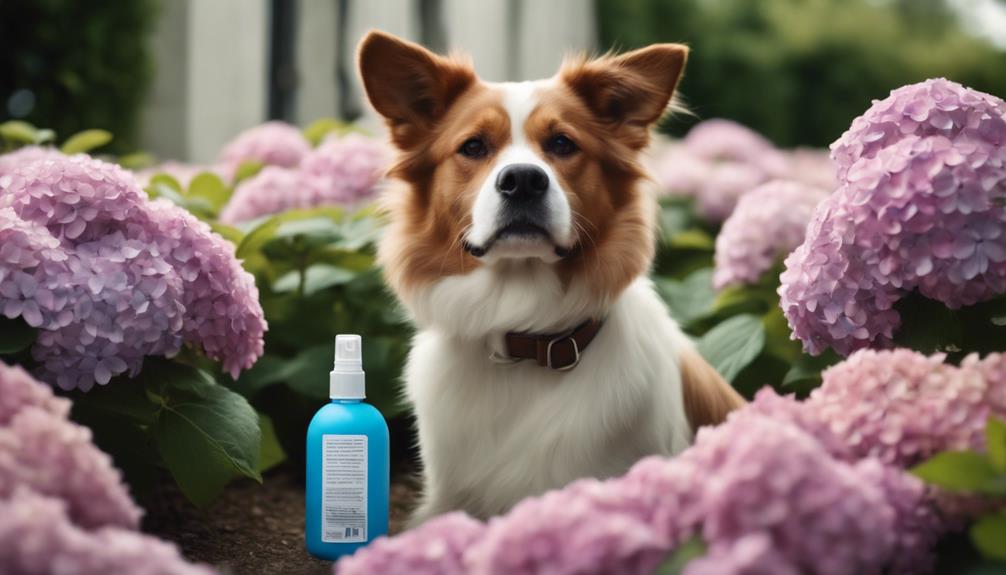
How can vigilant monitoring of hydrangeas ingestion aid in safeguarding the well-being of dogs?
Vigilant monitoring plays a crucial role in ensuring the safety of dogs exposed to hydrangeas. Here are some key points to consider:
- Observe Behavior: Watch for any signs of distress or unusual behavior in your dog.
- Monitor Symptoms: Keep an eye out for symptoms of poisoning such as vomiting, diarrhea, or lethargy.
- Track Ingestion Amount: Note the quantity of hydrangeas ingested to provide accurate information to the veterinarian if needed.
- Seek Immediate Help: If any concerning symptoms arise, contact a veterinarian promptly for guidance on next steps.
Seeking Veterinary Care
Seeking prompt veterinary care is imperative when a dog shows symptoms of hydrangeas poisoning to ensure timely and appropriate treatment. If a dog exhibits signs such as vomiting, diarrhea, lethargy, hypotension, tremors, brick-red gum coloring, or difficulty breathing after ingesting hydrangeas, immediate medical attention is necessary.
Veterinarians can assess the severity of poisoning, provide supportive care such as intravenous fluids or medications to manage symptoms, and administer specific antidotes if cyanide toxicity is suspected. Delaying veterinary intervention can result in worsening health conditions for the dog.
Contacting a veterinarian or an animal poison control center promptly can help in determining the best course of action for the dog's well-being.
Decontamination and Monitoring
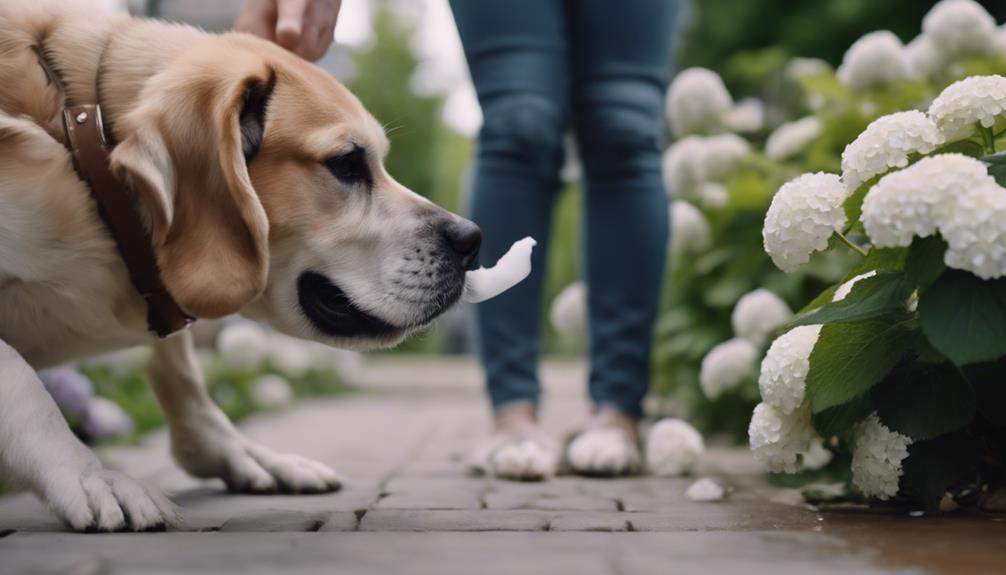
When addressing hydrangeas poisoning in dogs, one crucial aspect to consider is the process of decontamination and monitoring for any adverse effects. It is important to act swiftly and efficiently to minimize the potential harm caused by the ingestion of hydrangeas.
Here are key steps to follow:
- Inducing Vomiting: If hydrangeas were recently ingested, inducing vomiting can help expel the toxins from the system.
- Activated Charcoal: Administering activated charcoal can help absorb any remaining toxins in the stomach.
- Fluid Therapy: Providing fluid therapy can help flush out the toxins and support the dog's hydration.
- Monitoring for Symptoms: Continuously monitor the dog for any signs of distress or worsening symptoms post-ingestion.
Contacting Pet Poison Helpline
Contacting the Pet Poison Helpline can provide immediate guidance and assistance in cases of hydrangeas poisoning in dogs.
If you suspect your dog has ingested hydrangeas and is showing symptoms of poisoning such as vomiting, lethargy, diarrhea, hypotension, tremors, brick-red gum coloring, or difficulty breathing, it is crucial to seek help promptly.
The Pet Poison Helpline offers 24/7 access to animal poison control experts who can provide specific advice tailored to your dog's situation.
When contacting the helpline, be prepared to provide information about the type and amount of hydrangeas ingested, your dog's weight, and any symptoms observed.
Quick action and expert guidance from the Pet Poison Helpline can greatly assist in managing hydrangeas poisoning in dogs.
Dog-Safe Plant Alternatives
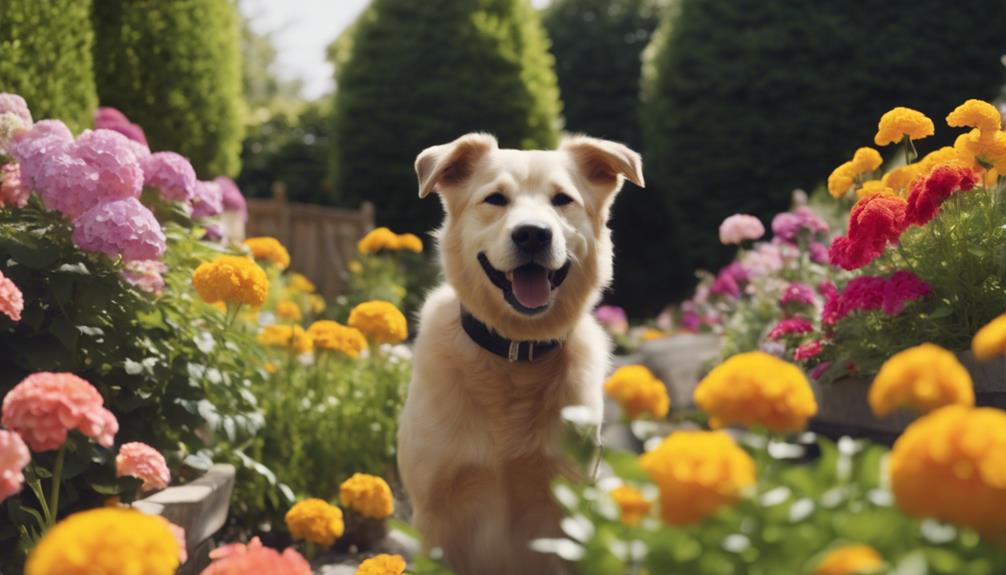
Exploring dog-safe plant alternatives can help create a pet-friendly environment in your garden. Consider the following options:
- Rose Bushes: Roses are a safe and beautiful option for your garden, adding color without posing a threat to your furry friends.
- Mulberry Bushes: Mulberries are dog-safe and produce delicious fruits that both you and your pet can enjoy.
- Black Hawthorn Trees: These trees are safe for dogs and provide a lovely addition to your landscape with their dark foliage and white flowers.
- Crimson Bottlebrush Shrubs: These shrubs are dog-friendly and attract hummingbirds with their unique red flowers.
Safe Shrub Options for Dogs
Considering the safety of your canine companion, selecting shrubs that are non-toxic to dogs is paramount in creating a secure outdoor environment for your pet. Opting for safe shrub options ensures peace of mind and prevents potential harm to your furry friend.
Dog-friendly alternatives to hydrangeas include rose bushes, mulberry bushes, black hawthorn, crimson bottlebrush, magnolia bushes, and chaparral. These shrubs not only add beauty to your garden but also provide a safe environment for your dog to explore without the risk of toxicity.
Prioritizing the selection of non-toxic shrubs is a proactive step towards safeguarding your pet's well-being while still enjoying a vibrant outdoor space.
Exploring Dog-Safe Plants
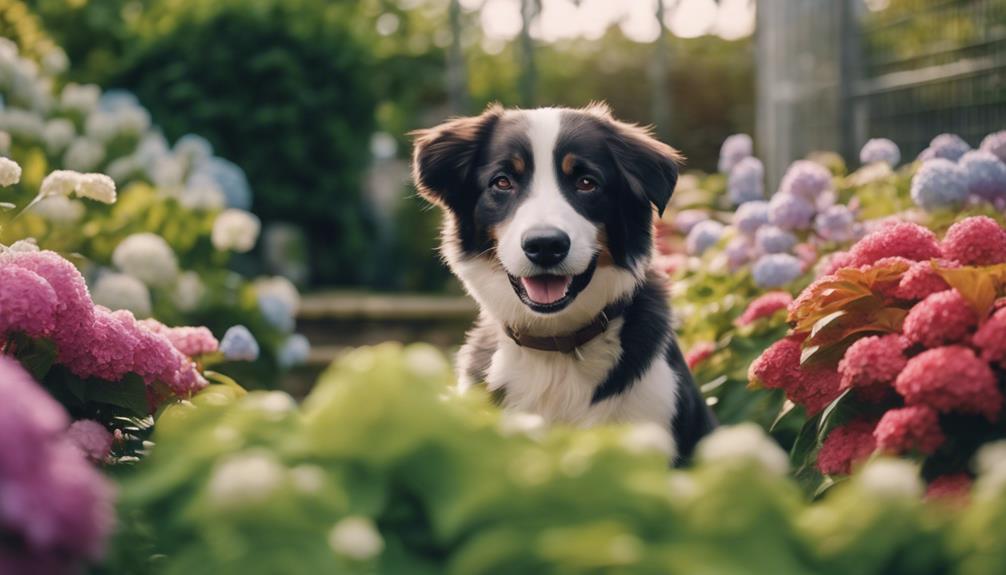
Prioritizing the health and safety of your canine companion involves selecting plants that are non-toxic to dogs, ensuring a secure outdoor environment for your pet. When exploring dog-safe plants, consider the following options:
- Lavender: Known for its calming scent, lavender is safe for dogs and adds a pleasant aroma to your garden.
- Sunflowers: These bright and cheery flowers are non-toxic to dogs and can bring a pop of color to your outdoor space.
- Blueberries: Not only safe for dogs, but also a healthy treat for them to enjoy, blueberry bushes can be a functional and pet-friendly addition.
- Ferns: Ferns are a great choice for adding greenery to your garden while keeping your furry friend safe from harm.
Choose these dog-safe plants to create a beautiful and pet-friendly outdoor environment.
Additional Tips for Pet Safety
To enhance the overall safety and well-being of your beloved pets, implementing additional precautionary measures is paramount.
In addition to being mindful of toxic plants like hydrangeas, it is essential to secure your garden or yard by installing barriers to prevent access to harmful flora. Regularly inspect the outdoor environment for any new plant additions that could pose a threat to your pets.
Educate yourself on the symptoms of plant poisoning and keep emergency numbers for poison control readily available. Consider enrolling in pet first aid courses to enhance your preparedness for any unforeseen incidents.
Conclusion
In conclusion, awareness of the toxicity of hydrangeas to dogs is crucial for pet owners to safeguard their canine companions. Understanding the harmful effects of cyanogenic glycosides and recognizing the signs of poisoning can help prevent potential risks.
By implementing preventive measures and exploring dog-safe plant alternatives, dog owners can create a safe environment for their furry friends. Prioritizing pet safety amidst the allure of garden flora is paramount for ensuring the well-being of dogs.




